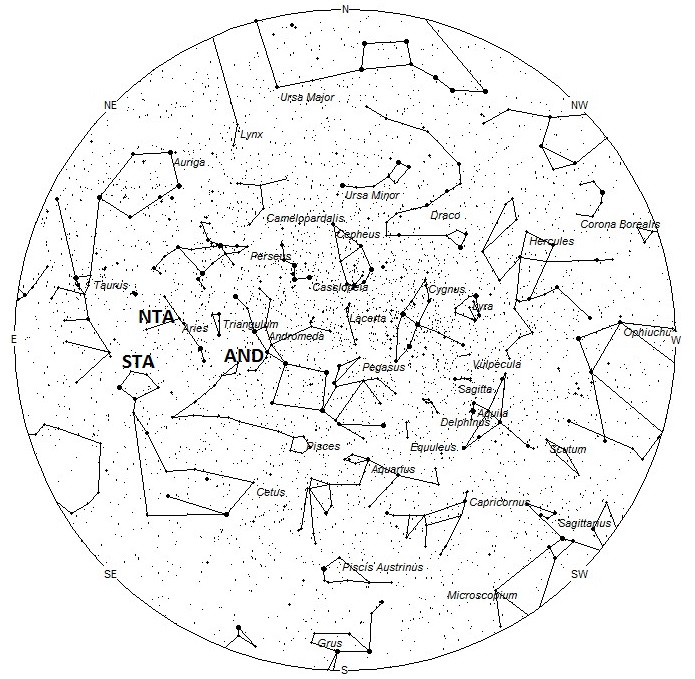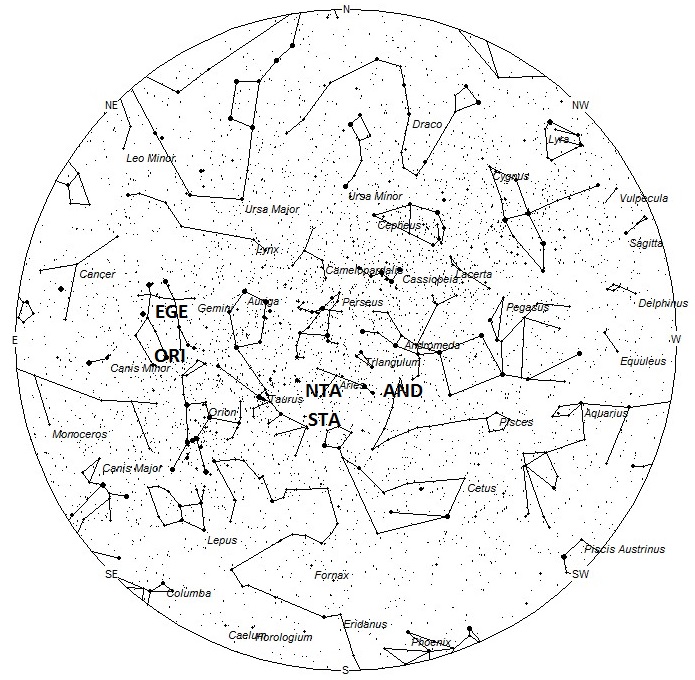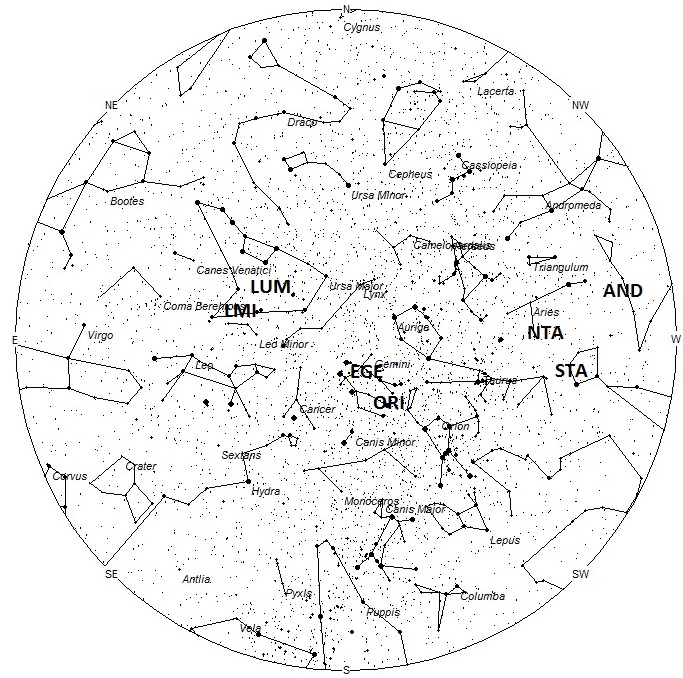During this period the moon reaches its first quarter phase on Thursday October 30th. At this time the moon is located 90 degrees east of the sun and sets near 2300 local daylight time as seen from mid-northern latitudes. The estimated total hourly meteor rates for evening observers this week is near 3 as seen from the northern hemisphere and 2 as seen from southern tropical latitudes. For morning observers the estimated total hourly rates should be near 22 for observers located in mid-northern latitudes and 17 for south tropical observers. Rates are reduced for the evening hours during this period due to moonlight. The actual rates will also depend on factors such as personal light and motion perception, local weather conditions, alertness and experience in watching meteor activity. Note that the hourly rates listed below are estimates as viewed from dark sky sites away from urban light sources. Observers viewing from urban areas will see less activity as only the brightest meteors will be visible from such locations.
The radiant (the area of the sky where meteors appear to shoot from) positions and rates listed below are exact for Saturday night/Sunday morning October 25/26. These positions do not change greatly day to day so the listed coordinates may be used during this entire period. Most star atlases (available at science stores and planetariums) will provide maps with grid lines of the celestial coordinates so that you may find out exactly where these positions are located in the sky. A planisphere or computer planetarium program is also useful in showing the sky at any time of night on any date of the year. Activity from each radiant is best seen when it is positioned highest in the sky, either due north or south along the meridian, depending on your latitude. It must be remembered that meteor activity is rarely seen at the radiant position. Rather they shoot outwards from the radiant so it is best to center your field of view so that the radiant lies at the edge and not the center. Viewing there will allow you to easily trace the path of each meteor back to the radiant (if it is a shower member) or in another direction if it is a sporadic. Meteor activity is not seen from radiants that are located below the horizon. The positions below are listed in a west to east manner in order of right ascension (celestial longitude). The positions listed first are located further west therefore are accessible earlier in the night while those listed further down the list rise later in the night.
These sources of meteoric activity are expected to be active this week:
The first activity from the Andromedids (AND) will be seen this week. This is a famous shower that produced some brilliant displays during the 19th century. Since then the main orbit of the particles from comet 3D/Biela have moved away from the Earth. Still, remnants may be seen from October 26 through November 20 with maximum activity occurring on November 8. The radiant is currently located at 01:20 (020) +22, which lies in eastern Pisces, 10 degrees west of the 2nd magnitude star Hamal (Alpha Arietis). Rates would most likely be less than 1 per hour no matter your location. With an entry velocity of 19 km/sec., the average Andromedid meteor would be of slow velocity.
The Southern Taurids (STA) are currently active from a radiant located at 03:04 (046) +12. This position lies in southeastern Aries, 8 degrees north of the 3rd magnitude star known Menkar (Alpha Ceti). These meteors may be seen all night long but the radiant is best placed near 0100 LDT when it lies on the meridian and is located highest in the sky. Rates at this time should be near 3 per hour regardless of your location. With an entry velocity of 29 km/sec., the average Southern Taurid meteor would be of slow velocity.
The Northern Taurids (NTA) are now active from a large radiant centered at 03:08 (047) +20, which lies in eastern Aries, close to the position occupied by the fourth magnitude star known as Delta Arietis. The radiant is best placed near 0200 LDT, when it lies highest above the horizon. Meteors from the Northern Taurids strike the atmosphere at 29km/sec., which would produce meteors of slow velocity. Expected rates would be near two per hour, no matter your location.
The Orionids (ORI) are active from a radiant at 06:36 (099) +16, which places it in southwestern Gemini, close to the spot occupied by the 2nd magnitude star known as Alhena (Gamma Geminorum). This area of the sky is best placed in the sky near 0500 LDT, when it lies highest above the horizon. The maximum for the Orionids was weak so rates this week should only be near 3 per hour no matter your location. With an entry velocity of 67 km/sec., most activity from this radiant would be of swift speed.
The Epsilon Geminids (EGE) are still active from a radiant is located at 07:08 (107) +27. This area of the sky lies in central Gemini, directly between the 1st magnitude star Pollux (Beta Geminorum) and 3rd magnitude Mebsuta (Epsilon Geminorum). The radiant is best placed in the sky during the last hour before dawn, when it lies highest above the horizon in a dark sky. Current rates should be near 2 per hour as seen from the northern hemisphere and near 1 when view south of the equator. With an entry velocity of 70 km/sec., most activity from this radiant would be of swift speed.
The last of the Leonis Minorids (LMI) will be seen this week. The radiant is currently located at 10:56 (164) +36. This position lies in northeastern Leo Minor near the faint star known as 46 Leonis Minoris. This position is also close to the mid-way point between the brighter stars Nu and Upsilon Ursae Majoris. This area of the sky is best placed in the sky during the last hour before dawn, when it lies highest above the horizon in a dark sky. Current rates should be near 1 per hour as seen from the northern hemisphere and less than 1 as seen from south of the equator. With an entry velocity of 68 km/sec., most activity from this radiant would be of swift speed.
The Lambda Ursae Majorids (LUM) are a recent discovery by Zeljko Andreic. This weak shower is active from October 24 through November 1st with maximum activity occurring on the 27th. The radiant currently located at 10:20 (155) +50. This position lies in a sparse area of central Ursa Major, between the 2nd magnitude star Merak (Beta Ursae Majoris) and 3rd magnitude Tania Borealis (Lambda Ursa Majoris). This area of the sky is best placed in the sky during the last hour before dawn, when it lies highest above the horizon in a dark sky. Current rates should be near 1 per hour as seen from the northern hemisphere and less than 1 as seen from south of the equator. With an entry velocity of 62 km/sec., most activity from this radiant would be of swift speed.
As seen from the mid-northern hemisphere (45N) one would expect to see approximately 10 sporadic meteors per hour during the last hour before dawn as seen from rural observing sites. Evening rates would be near 2 per hour. As seen from the tropical southern latitudes (25S), morning rates would be near 7 per hour as seen from rural observing sites and 1 per hour during the evening hours. Locations between these two extremes would see activity between the listed figures. Moonlight reduces the number of meteors seen during the evening hours during this period.
The list below offers the information from above in tabular form. Rates and positions are exact for Saturday night/Sunday morning except where noted in the shower descriptions.
| SHOWER | DATE OF MAXIMUM ACTIVITY | CELESTIAL POSITION | ENTRY VELOCITY | CULMINATION | HOURLY RATE | CLASS |
| RA (RA in Deg.) DEC | Km/Sec | Local Daylight Time | North-South | |||
| Andromedids (AND) | Nov 08 | 01:20 (020) +22 | 19 | 23:00 | <1 – <1 | III |
| Southern Taurids (STA) | Oct 10 | 03:04 (046) +12 | 29 | 01:00 | 3 – 3 | II |
| Northern Taurids (NTA) | Oct 22 | 03:08 (047) +20 | 29 | 01:00 | 2 – 2 | II |
| Orionids (ORI) | Oct 22 | 06:36 (099) +16 | 67 | 05:00 | 3 – 3 | I |
| Epsilon Geminids (EGE) | Oct 22 | 07:08 (107) +27 | 70 | 06:00 | 2 – 1 | II |
| Lambda Ursa Majorids (LUM) | Oct 27 | 10:20 (155) +50 | 62 | 09:00 | 1 – <1 | IV |
| Leonis Minorids (LMI) | Oct 22 | 10:56 (164) +36 | 60 | 10:00 | 1 – <1 | II |
 American Meteor Society
American Meteor Society



Is there anything going on tonight? Several people in neighboring towns report hearing a loud boom here tonight, maybe round 11:00 pm. just curious if it was a meteor landing.
Lisa,
It would help to know your location. A sonic boom does not necessarily guarantee a meteor landing. It does indicate the meteor reached the lower portion of the atmosphere and that fragments could have reached the surface.
Robert Lunsford
I saw 2 meteor “streaks” on October 31st from Lawrence KS. I am assuming they were from the LUM shower.
Stephanie,
The Lambda Ursae Majorids are a pretty weak shower. Chances are they were either random meteors or members of the Orionids or Taurids.
Robert Lunsford
Stephanie,
The Lambda Ursae Majorids are a pretty weak shower. Chances are they were either random meteors or members of the Orionids or Taurids. Since it was early evening they were most likely random or Taurids.
Robert Lunsford
I saw them around 8pm ish that night.